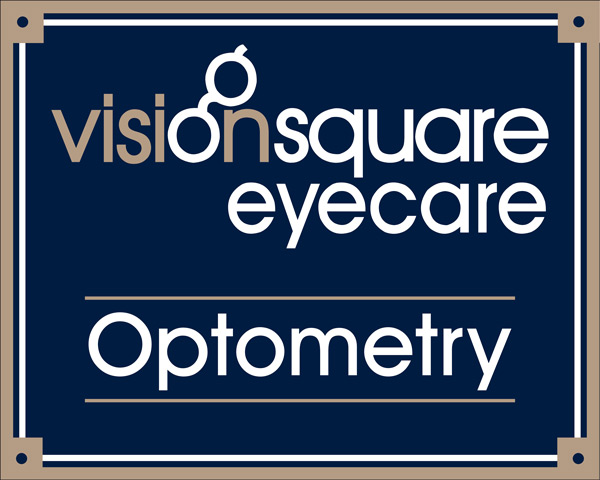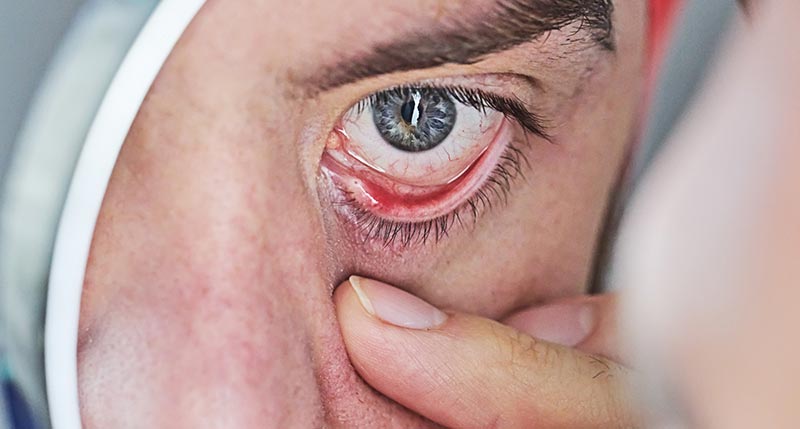July is National Dry Eye Awareness Month. It is estimated that at least 17 million and up to 50 million Americans suffer moderate to severe symptoms from Dry Eye. Twice as many women as men experience the pain and discomfort of Dry Eye. A significant percentage of diagnoses in women can be attributed to certain types of birth control, pregnancy, hormone replacement therapy, and menopause.
Misdiagnosis of Dry Eye can cause damage to the tissues of the eye, so it’s important that you visit your optometrist for a thorough eye exam to get a proper diagnosis, determine the contributing causes of your condition, and treat your symptoms effectively.
What is Dry Eye?
Your eyes constantly produce tears, creating a “tear film” to lubricate the eyes, maintain a smooth surface for light refraction, and preserve the health of the conjunctiva and cornea. This tear film is made up of an outside fat-based oily layer, a watery middle layer, and an inner mucus layer that keeps the surface of the eyes lubricated. If any of these layers are lacking, the blinking that distributes tear film can’t occur smoothly and discomfort results. Not only is Dry Eye uncomfortable, but it can also, in some instances, negatively impact your vision.
What are the two types of Dry Eye?
- Evaporative Dry Eye: This type of Dry Eye is the most common and is caused by not having enough of the oil that prevents evaporation in the tear film. This condition is termed MGD (Meibomian Gland Dysfunction). It is defined as eyelid glands that don’t produce enough oil or produce oil of poor quality.
- Aqueous-Deficient Dry Eye: This type occurs when the lacrimal glands don’t make enough of the watery component of the tear film. It can be attributed to specific autoimmune conditions, hormonal changes, certain medications, and aging.
What are risk factors of Dry Eye?
There are many and varied risk factors associated with Dry Eye, many of which you can’t control but some that you can control:
- You’re at greater risk if you are over age 50.
- Hormonal changes or medications that affect hormones are a risk factor — which is the reason why a greater percentage of women suffer from Dry Eye.
- Certain medications, including meds used to treat glaucoma.
- Medical conditions like thyroid disorders, diabetes, rheumatoid arthritis, rosacea, Sjogren’s Syndrome, Lupus, and others.
- Decreased blink rate that can be caused by frequent or prolonged screen use or by diseases such as Parkinson’s.
- Inflammation of the eyelids or eyelid conditions that prevent eyelids from closing completely.
- Lasik or other refractive surgery
- Contact lenses
- Poor make-up hygiene
- Allergies, dry climate, exposure to smoke, or other environmental conditions
What are the symptoms of Dry Eye?
Just because you have some of the Dry Eye symptoms listed below doesn’t mean that you have Dry Eye. Your optometrist will review your symptoms along with your medical history to diagnose your condition properly. Following are the common symptoms of Dry Eye:
- Increased sensitivity to light
- Extreme sensitivity – particularly to cigarette, cigar, or vape smoke
- Blurry vision
- Stinging or burning
- Inflammation or redness
- Itchiness
- Sandy or gritty feeling
- Stringy mucus or particles in the eye
How can I get relief from Dry Eye?
- Use a Humidifier: In living areas that use heaters or air conditioning, a humidifier can help keep natural moisture in the air. If you live in a dry, arid climate, a humidifier can keep your eyes more comfortable.
- Avoid low humidity conditions: Limit forced air heating, air conditioning, hair dryers, and even windy conditions if possible. Be especially aware of airflow in cars and airplanes where vents blow directly in your face and eyes. Avoid cigarette, cigar, pipe, or vape smoke.
- Take frequent screen breaks: Take a screen break every 20 minutes and remember to blink frequently to lubricate your eyes.
- Hydrate: Drink water to keep your eyes and body fully hydrated.
- Consult your optometrist: Your Dry Eye symptoms may be related to wearing contacts or using glaucoma eye drops. Your optometrist can discuss the options available to help with your symptoms – which may include taking specific vitamins or Omega-3 supplements.
- Over-the-counter treatment options: Artificial tears that replace the natural tear film of the eye are available over-the-counter and can provide symptom relief, but they are not a treatment for Dry Eye. There are many formulations and brands with different ingredients, including ones with preservatives and preservative-free. Frequent and prolonged use of artificial tears, particularly those with preservatives, can cause irritation or allergic reactions. So, it’s important to discuss their use with your optometrist. Ointments may also be used before bedtime to help eyes stay moisturized during the night.
- Eyelid Care: If eyelid irritation is causing your Dry Eye symptoms, your optometrist may recommend massaging your eyelids, and using eyelid cleanser or warm compresses to help reduce inflammation.
- Prescription Medications: Your optometrist may suggest oral medications, nasal spray, or eye drops in more serious cases of Dry Eye.
- Dry Eye Treatments: Tear duct plugs, Meibomian gland procedures that release clogged oil glands, and surgery to tighten your eyelids and keep tears in your eyes are options in the most severe cases of Dry Eye.
Dry Eye is a treatable condition, and your optometrist can answer your questions and discuss a treatment plan to help you achieve healthier eyes. Your eyes are your “windows on the world” and deserve the best of care.
Call us to schedule your annual comprehensive eye exam today to keep your eyes healthy and your vision clear. Let’s work together to ensure you enjoy great vision for years to come!

